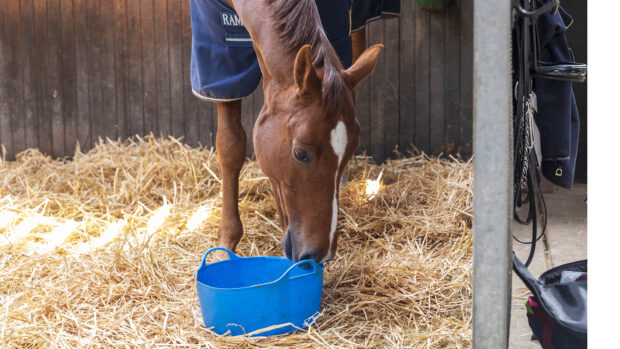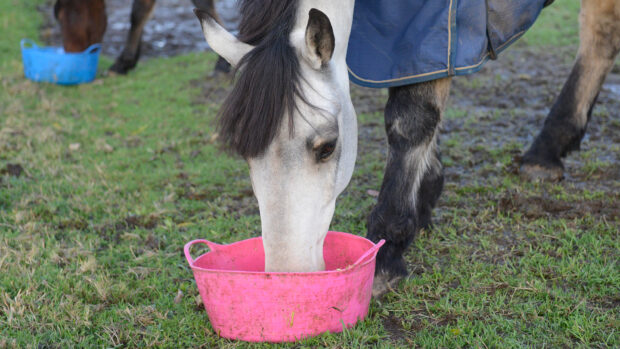Historically, most horse owners and grooms fed their horses a diet of cereals, such as oats and boiled barley, in addition to hay. During the 1950s, horse and pony nuts were introduced, and in the years that followed, a complete feed was developed for each and every horse. These days, owners are spoilt for choice with a vast range of feeds, supplements and balancers available – but how did we get here?
1834 – First supplement – Thomas Day, of Day & Sons, starts manufacturing supplements. The equine tonic ‘Black drink’ costs 10 shillings per half-dozen bottles.
1906– Nobel Prize-winning biochemist Frederick Hopkins suggests the existence of vitamins in the human body. In 1912 he publishes a key paper on the subject. This knowledge proves vital in the fields of human and veterinary nutrition.
1907 – Nobel Prize-winning immunologist Elie Metchnikoff introduces the concept of probiotics to benefit humans. These live microbes will later prove popular in animal nutrition.
1920 – Early experimentation begins on the effectiveness of feeding yeast culture to livestock, although equine trials are not carried out for another 60 years.
1929 – The Equivite trademark is registered and its vitamin and mineral mix for horses is launched.
1935 – The first cod liver oil product for horses and ponies is launched, Super Solvitax Pure Cod Liver Oil.
1958 – First pony nuts – The first compound feed for horses, SPILLERS Horse and Pony Cubes, is launched.
1960 – The first compound feed for racehorses, SPILLERS Racehorse Cubes, is introduced, followed in 1961 by the first compound feed for broodmares and youngstock, SPILLERS Stud Cubes.
1977 – A dust-free, bagged-forage product providing optimum protein and energy levels is launched, HorseHage Ryegrass.
1977 – The first bagged, chopped-fibre feed is introduced by Youngs Animal Feeds, Super Molichop Original.
1978 – The first extruded horse feed is launched by Badminton Speciality Feeds, Triple Crown Extruform. (Extruding involves cooking different feed elements together at high temperatures and reforming them.)
Late 1970s – Micronising, a rapid-cooking process using infra-red heat that increases the digestibility of starch, is pioneered by Dodson & Horrell. Subsequently, one of the first micronised cereal and oat diets, Microfeed, is launched.
1982 – The use of reprocessed bread is pioneered with Baileys’ No.1 Cooked Cereal Meal. Bread was the precursor of micronised wheat.
1983 – The yeast culture Yea-Sacc1026 is introduced by Biotechnology company Alltech, founded three years earlier.
1986 – First herbal calmer – The first herbal calmer for horses is launched, Feedmark’s Steady Up.
1989 – First balancer – The first feed balancer is launched under the provisional name of Gro-Well Equine Feed Balancer, before changing to Equilibra. The pelleted feed contains vitamins, minerals, proteins and yeast and is said to improve feed utilisation.
1989 – The first ‘flash-dried’ alfalfa chop, Alfa A (now called Alfa-A Original), is introduced to the UK market by Dengie, and high-temperature-dried alfalfa is hailed as ‘the introduction of forage feeds’.
1989 – The first balancer formulated specifically for breeding stock is developed by Baileys Horse Feeds. It allows for the feeding of a low-starch diet
Late 1980s – A revolutionary muesli diet for the leisure horse is introduced by Dodson & Horrell, Pasture Mix. The product is also one of the first horse feeds to contain herbs.
1990 – Following this year’s World Equestrian Games, extensive research is carried out on exercising horses in extreme heat by Kentucky Equine Research.
1990 – First for feet – The first complex formula to support hoof growth and health is launched by NAF, Hoof and Hide supplement.
1990 – Alltech launches bio-available [the extent to which a nutrient can be used by the body] organic minerals easily absorbed in the gut, Bioplex Trace Minerals.
1991 – First veteran feed – The first pellet-free muesli mix for the older horse, Allen & Page’s Old Faithful’s Special Blend, is launched.
1992 – Robert Eustace FRCVS, who sits on the scientific committee of the Laminitis Trust, highlights the link between obesity and laminitis, publishing the paper Explaining Laminitis and its Prevention.
1994 – First for laminitis – The first low-sugar/starch feed for animals prone to laminitis is developed by Dengie. Hi-Fi Lite is the first product to carry the Laminitis Trust Approval (the trust launches its feed approval mark seven years later).
1995 – The University of Guelph, Ontario, Canada, completes research leading to the first premium electrolyte for performance horses, Buckeye
Perform ’n Win.
1995 – The first coarse mix specifically formulated for horses and ponies prone to laminitis is launched. Allen & Page’s ‘L’ Mix is low starch/high fibre and includes herbs and Protexin, a probiotic.
1996 – Dengie launches Alfa-Beet, a product containing unmolassed sugar beet and alfalfa, which needs only three hours of soaking before being fed to horses.
1996 – Blue Chip launches Original Feed Balancer, one of the first products to include easily utilised chelated bioplex minerals and yeast cultures. (A bioplex is a mineral bound to a protein; chelation describes the bonding process.)
1996 – The first feed to address the issue of dietary intolerances is launched, Allen & Page’s Sugar & Cereal Intolerance Diet.
1997 – Dr Karen Hinkley presents work on the implication of fructans [fructose polymers and storage carbohydrates] in the onset of laminitis at the second Dodson & Horrell International Conference on Feeding Horses.
1997 – First for joints – A revolutionary nutraceutical feed supplement to increase joint soundness is launched in America. Cortaflex is released in the UK the following year by Equine America UK and contains chondroitin and glucosamine to stimulate synovial fluid and maintain healthy joints.
1997 – A product containing 25% Omega 3 oil, said to help joints and connective tissues, is launched, Super Solvitax Double Strength R-A Formula.
1997 – The first antioxidant feed supplement for horses, D-Tox, is launched by NAF.
1997 – The first very high oil (14%) coarse-mix feed is launched in the UK, WINERGY Advanced Energy.
1998 – The first scientifically developed joint supplement combining glucosamine, chondroitin and MSM is developed, NutriScience’s ArthriAid.
1998 – A high-specification feed balancer for the performance horse is launched. Blue Chip Pro combines yeast cultures, chelated minerals and probiotics.
1999 – First for sweet itch – The first feed supplement to tackle sweet itch, D-Itch, and Mud Gard, the first to address mud fever, are launched by NAF.
2000 – The first ‘synbiotic’ supplement to combine yeast, probiotics and prebiotics is launched by Dengie, XP Triple Action.
2000 – The first chopped-fibre feed with a broad spectrum of vitamins and minerals for horses at risk of laminitis is launched, SPILLERS Happy Hoof.
2000 – The first feed balancer to include the levels of vitamins and minerals previously only found in specific supplements is introduced, TopSpec Feed Balancer. It is also the first to combine high levels of protected yeast with MOS prebiotics (complex molecules concentrated from yeast).
2000 – First for tying-up – The first feed for horses prone to tying-up is launched by Dodson & Horrell. ERS is a low starch/high energy mix.
2000 – Primero Equine, the feed company with a ‘one-feed philosophy’, launches Total, a clinically researched fibre feed said to eliminate the need for supplements.
2001 – First for endurance – The first specific diet for endurance horses is introduced, Saracen’s Enduro 100.
2002 – De Montfort University carries out research with Feedmark into the causes of crib biting and windsucking, and the antacid Settelex is launched.
2002 – Feed balancers developed for specific equine diets are introduced by Equizest Limited: Straights Balancer, Compound Balancer, E-Plus and Forage Balancer.
2002 – Saracen launches its low-glycemic range, Super Fibre Pencils, Level Grow Mix and Re-leve. (Low-glycaemic foods help blood glucose levels to rise slower than high-glycaemic foods in response to complex, starchy carbohydrates.)
2003 – First no-soak beet – Youngs Animal Feeds launches Super Molichop Shreddi, sugar beet shreds in a fibre feed that requires no soaking.
2003 – The vital role of antioxidants in the horse’s diet when grass is restricted is highlighted in the Equine Veterinary Journal.
2003 – The only equine respiratory supplement to have been proven in published scientific trials is launched, WINERGY Ventil-ate.
2003 – Global Herbs launches Laminitis Prone Supplement, said to support the liver and help the condition effectively in a week.
2004 – EU registration is given to the yeast culture Yea-Sacc1026 for use in
equine diets.
2004 – Dengie expands its Alfa-A and Hi-Fi ranges with the introduction of Alfa-A Oil, Alfa-A Lite and Hi-Fi Senior.
2004 – Equi Life launches Formula4Feet, an equine hoof supplement that uses ingredients from non-GM plant sources.
- This feature was first published in HORSE magazine (October 04)
SUBSCRIBE TO ‘HORSE’ AND SAVE UP TO 30%Subscribing to HORSE has never been easier. You can enjoy the convenience of doorstep delivery at big savings on the full subscription rate, as well as avoiding any cover price rise during your subscription period. 



